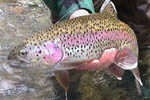|
I first thought of this pattern
while fishing a standard muddler for landlocked salmon one day in
early July. In the past, while fishing for trout, I had wondered why
I would frequently notice trout swimming up to a standard muddler
only to get a bird's eye view and reject the fly. That day in early
July, I decided that a muddler with less shine in the body would be
just the thing. I decided that a fur thorax or rabbit fur would
accomplish this. An evening on the "Punch Bowl" proved to me that
this muddler variation was a success.
The "Punch Bowl", as it is known
by the locals who fish it, is a 45-minute bike ride (30 minutes
uphill!) from where I live. The fish that inhabit the Bowl are
immensely fat, due to a prolific damsel nymph population. I fish
this pond every summer, as it is known to produce brookies over 4
pounds. Catching them is something of a task, and oddly enough only
a few fishers are aware of its existence. As far as brookies go, I
have never witnessed any behaviour similar to these fish anywhere on
the Island. These fish can usually be taken only after the sun goes
down, and an east to northeast wind with lots of fog brings out the
biggest fish… strangest behaviour I have ever seen in Brook
Trout.
They can usually be caught any
time, day or place here on the "Rock", but not this particular
strain. I catch between one and three on a good night, but on many
nights I catch none. A good day on any other pond on the island,
depending on the time fishing, would result in catch of 12 to 30. In
a stream or creek, catching 40 plus is no problem if you're willing
to move around.
I had arrived at the "Bowl" about
10 minutes before sundown. The wind was wicked and the fog was
thick. Getting my 5 wt. line on the water was a chore. I had just
made my third cast and BAM. At first I assumed my usual fat and
stout 14- to 16-incher. So, I started to strip the line, except TUG.
This fish was not like the rest. In my estimation, this fish was at
least 4 pounds. I say estimation because I never did land it. I had
only fought it for about (honestly) 40 seconds when it wrapped the
3X tippet around a submerged stump, paused for a moment, and ripped
my muddler from its mouth. I had lost the fish. But I also lost the
muddler, because almost simultaneously with the trout throwing the
fly, the tippet snapped as my pulling motion caused the hook to
lodge in that darn stump. Through the clear water, I watched in
amazement as the brookie paused momentarily before finally darting
off into the depths. I have never seen a trout this large in my
life, brook trout that is. It was almost as fat as it was long. I
can't wait to get back to the Bowl next year.
--Michael
Garnier
|



